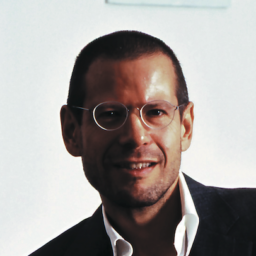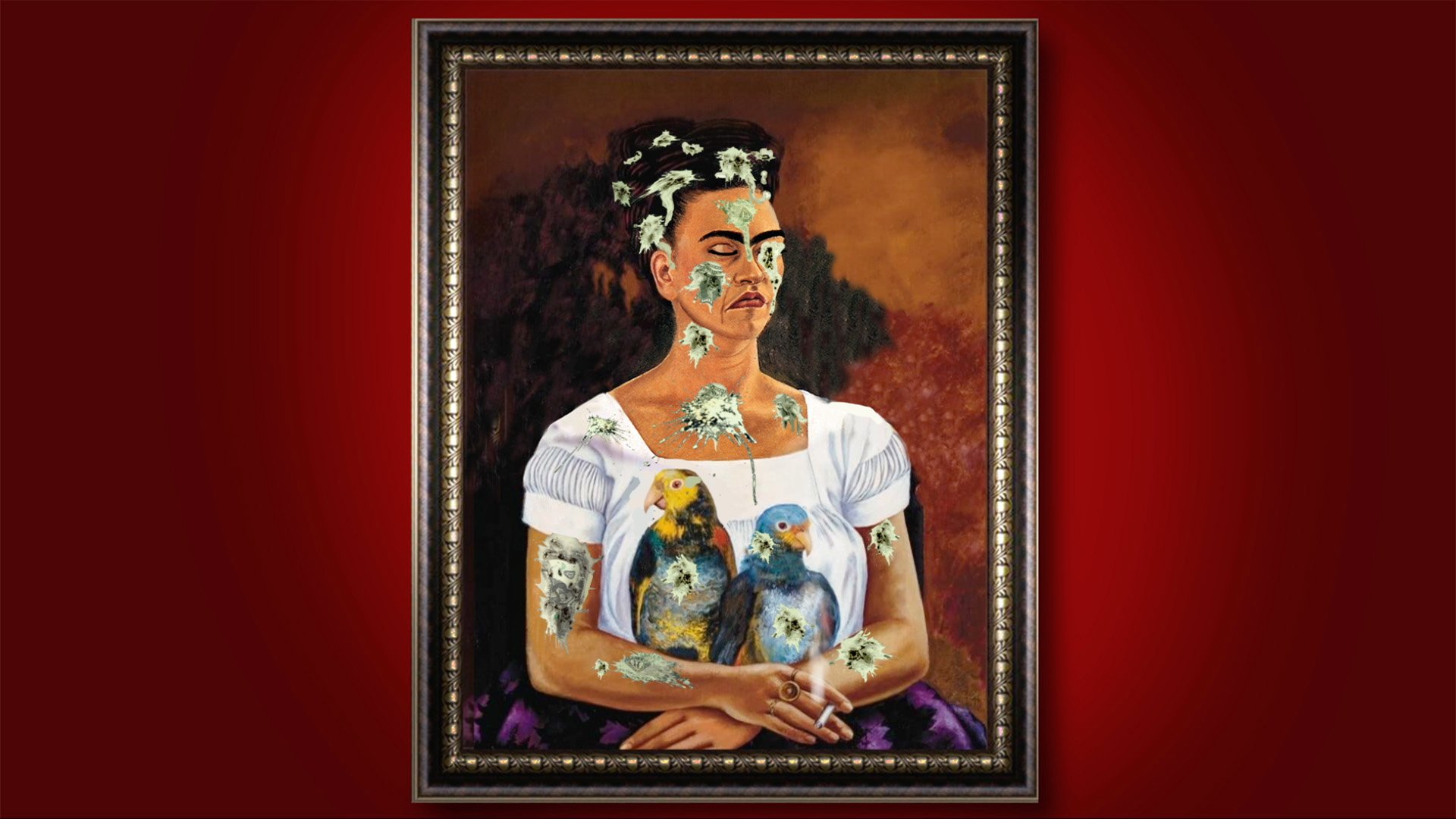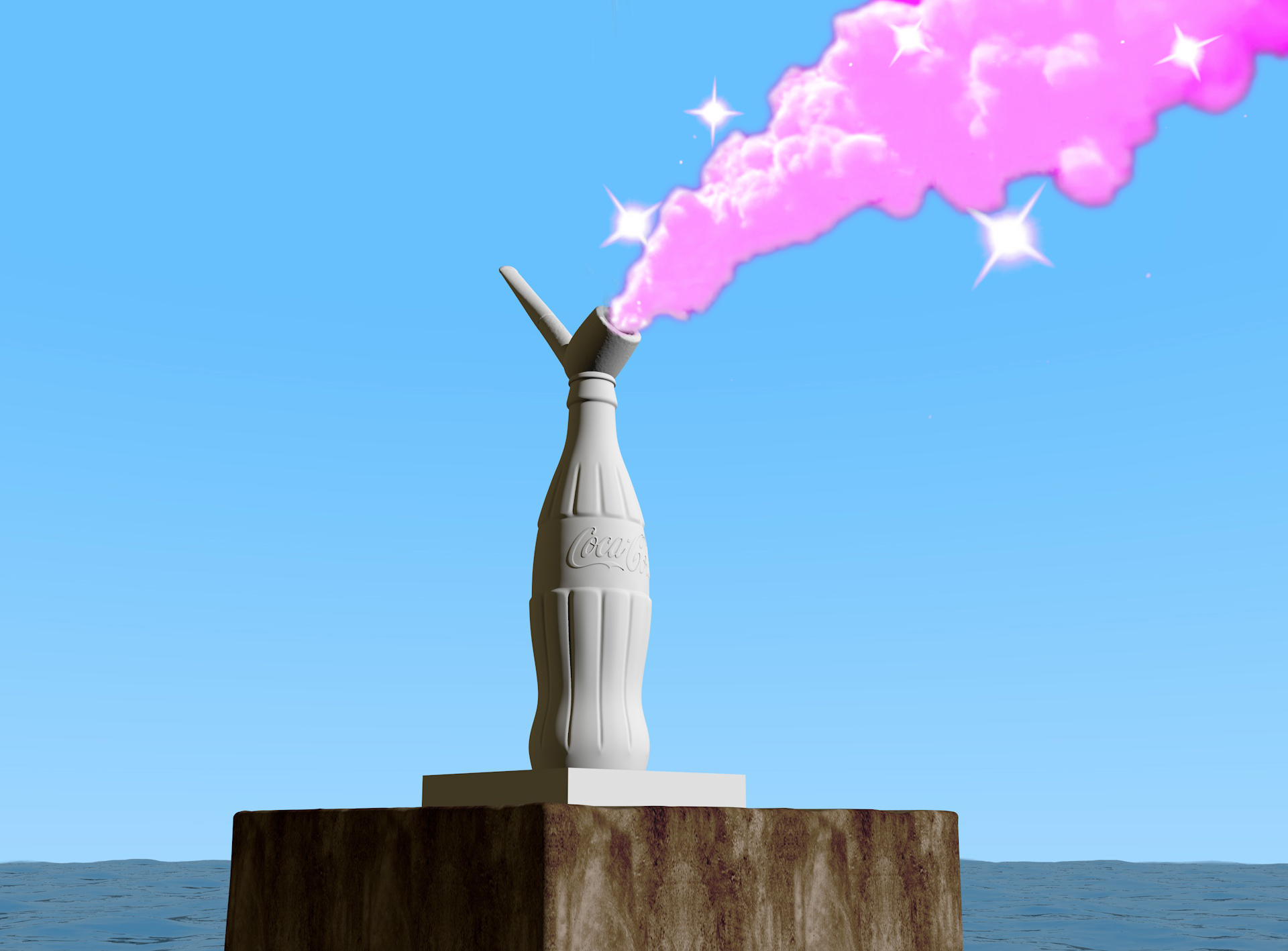Before I resume with more of the crypto content you’ve come to expect from me of late (apologies in advance), here’s some juicy meatspace fodder to chew on. Author Luis-Martín Lozano spent 30 years ferreting out all 152 paintings ever painted by Frida Kahlo, many of which have remained hidden in private collections, now documented in a “gorgeously illustrated $200 tome (published by Taschen) that includes reproductions and analysis of all of Kahlo’s known paintings, including several works that have been lost.”
Here is another heretofore undisclosed but equally compelling fact I recently dug out on the artist. A long-term holder of a Kahlo self-portrait masterpiece wanted the best of both worlds: to remain anonymous, yet sell the painting to the highest bidder—a well-nigh impossible task.
Low and behold, Christie’s came up with a novel approach that seemingly accomplished the feat of a surreptitious secret sale this summer—until now that is. When it comes to generating fees, the auction houses have proven time and again to be the most nimble in the field, far outpacing galleries in ingenuity and cleverness (witness their aggressive role in commercializing NFTism).
The solution was to conduct a closed auction amongst a handpicked clique of interested parties. Not a sealed bid—but rather a full-on, real-time, live auction. The result: a whopping $130 million-plus achieved for the work, Me and My Parrot, from 1941. Word is that the painting went to an Asian collector, further substantiating a major market migration of Western art to the region. (Christie’s did not immediately respond to a request for comment.)
One more little item before I jump back online. I thought it would be cool for this edition of the column to interview Larry G., who has remained a singular force in the art world for in excess of 40 years. I’m nothing less than a fan. I sent a text to that effect, to which he replied: “Too much Larry is not good.” (I countered that too much Larry is never enough.) He demurred that he was taking August off (highly suspect knowing his legendary frenetic deal-making mania), after which he was spotted swanning around Europe from a sold out Jenny Saville exhibition he organized at the famed Casa Malaparte in Capri (a summer tradition for Gagosian), to the beaches of St. Tropez with new girlfriend Anna Weyant in tow. Weyant is a Canadian painter and 2017 graduate of Rhode Island School of Design who catapulted to art stardom after her first sell-out one-person show at 56 Henry in 2019 shortly after her graduation. The in-demand market sensation, whose work resembles a feminist twist on John Currin, has recently signed with Blum & Poe Gallery in L.A.
Time to reboot. Governments have long held a stranglehold on currency since paper money—said to have been developed to enable Emperor Huizong (1082–1135) to facilitate the expansion of his extensive art collection, which was ultimately catalogued at 6,000 works—was put into circulation during the Song Dynasty in the 11th century. Was Huizong the first hoarder? My role model, in any event.
In more recent times, the extent of governmental control was demonstrated by the fact that Americans were prohibited from “hoarding” gold or silver coins from 1933 to 1975 under penalty of $10,000 fine or 10 years imprisonment (or both) before they became fully legal to own and trade. This was intended to enhance economic liquidity and jumpstart the economy after the Depression. We’ve come a hell of a long way since the elusive Satoshi Nakamoto (if he ever existed) authored Bitcoin, the decentralized digital currency traded between users on a peer-to-peer computer network without central bank intermediaries.
Speaking of money, Damien Hirst, who premiered his digital money NFT—surprise, surprise, my application to buy one was turned down after my repeated criticisms of Hirst—was just on CNBC declaring, “I love all the currencies.” No shit.
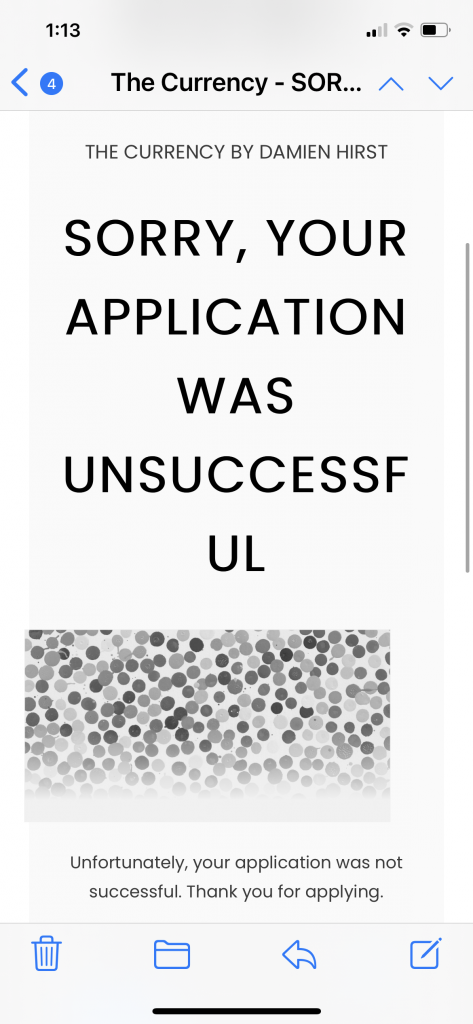
Sometimes rejection can be a blessing!
Not much has been the same since the advent of crypto. Vitaly Dmitriyevich “Vitalik” Buterin, a 27-year-old developer, and Gavin Wood, 41, took the phenomenon steps further with the creation of the Ethereum blockchain with smart contract functionality and its native currency Ether. Established to exist outside the purview of central bank controls, Bitcoin became known as “sound currency” for its value as a store of wealth. And now, after the recent modification of the protocol, Eth is referred to as “ultrasound” money, with its steady rise in value from under $1 in 2015 to a high of $4,382 in May 2021 before settling at around $3,270 at the time of this writing.
The London fork, as the recent changes to Ether are known, reduces transaction fees, begins to address environmental issues, and will entail burning some of the tokens in the process of mining, thereby reducing overall supply. The rise of Eth has been torrid; and, as the first practical application of digital money, is fast becoming the default crypto cash of the internet. It’s also served to underpin and fuel the NFT craze that shows no signs of abating—whether you like it or not!
OpenSea, the marketplace that resembles the eBay of NFTism (eBay is about to open its own NFT shop, by the way) has raised another $100 million in financing, catapulting it to the status of unicorn companies (with capitalization of over $1 billion), one of the few solely in NFT space. And, poignantly, OpenSea will forego expensive gas fees, the prohibitively expensive transactional costs associated with minting new artworks on chain. Investors in the most recent round of financing included Ashton Kutcher (maybe this will deter him from acting in more cringe-worthy TV shows), art trader Michael Ovitz (look for him to flip his shares), and basketball star Kevin Durant.
Even the high end (i.e. overpriced) collectible emporium 1stdibs is getting in on the game—meaning more overvalued NFT fare will enter the fray. In addition, blue-chip businesses aren’t missing their chance to participate, including Fortune, Burberry, Coca Cola, and a collaboration between Louis Vuitton and Beeple. I shudder to see what this will look like, but it least it distracts him from making more “art.” Lest I forget Stoner Cats: NFTs and an animated TV show produced by Mila Kunis, with the voices of Chris Rock, Ashton Kutcher, and Mr. Eth himself, Vitalik Buterin, is also in the works.
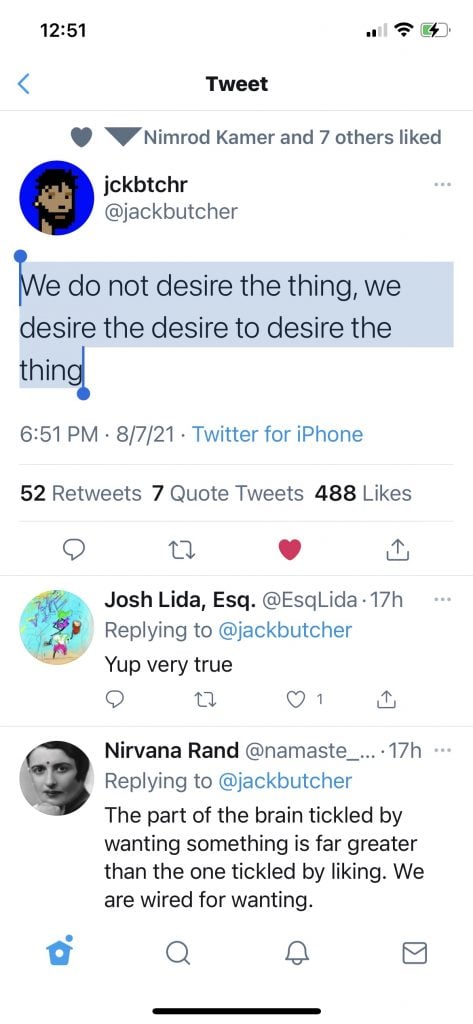
Crypto summation of the impetus to collect. Freud would be down!
Speaking of flippers, the NFT world has developed in parallel with the traditional art world at least with respect to aping the worst traits of the market. It has a host of short-terms players with names like “Pranksy” (who is said to have bought 1,000 Bored Ape Yacht Club monkeys) and “Beanie Maxi” who dip in and out of NFTs with a velocity quicker than the speed of light. The crypto world is not known as the Wild West of dirty digital warfare without cause—it is leap years ahead of the market machinations and price manipulations that transpire at pretty much every level of art auctions.
Here is a prime example: I have covered the proliferation of collectible NFT known as PFPs, generally goofy images that buyers use as their profile pictures in social media such as cartoonish elephants, squirrels, ghosts, rockets, goats, apes, dogs, punks, Covid punks, phunks, zunks, and unicorns, to name but a few. Generally minted in editions of 10,000, the default number after the resounding success of Punks, these digital assets have traded for over a billion dollars in total and counting.
Kevin Roose only just wrote in the New York Times about the latest PFT fad in an article entitled I Joined a Penguin NFT Club Because Apparently That’s What We Do Now. But he missed the ruse (pardon the pun, but it’s true). I only just met a high-frequency flipper that programmed dozens of bots to buy PFP NFTs when they reach low points (“floors”), creating the illusion of demand, then in turn gradually selling them back into an ever-increasingly market predicated on the false impression of demand. And it’s all effectuated by fully automated software. Bots scrape NFT marketplaces like OpenSea to buy series with declining price trends and consequently pump the market, like certain unnamed art families in our brick-and-mortar art world.
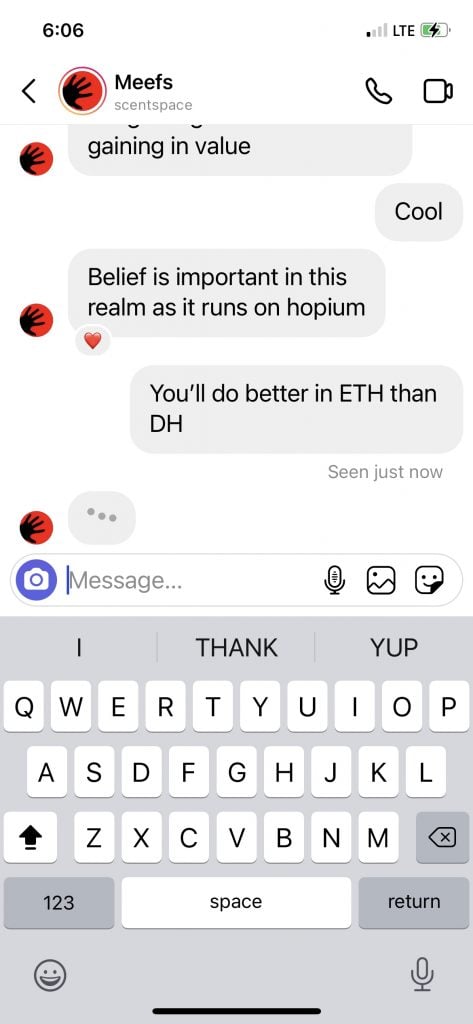
Much of NFTism is based on hopium, not to mention collecting art!
The entire penguin run-up in prices—the high stands at nearly $500,000—was orchestrated by the crypto cowboy I just had drinks with and a few of his DeFi (decentralized finance) friends. I once got into a tiff with the brilliant German artist Rosemarie Trockel in the early 1990s, and she wrote to me that the world is small and the art world is miniscule. The crypto world is atomic by comparison. Guess what? None of this in the least dampens my enthusiasm for NFTism. I’m still all in and going deeper.
A quick note on the resurgence in the NFT market over the summer since a well reported downturn in NFTs said to approach a 90 percent decline. A buyer says he bought 80 Crypto Punks in a single blockchain transaction for nearly $8 million (he’s added to his holdings since) and used a new technology to mask his purchase so he wouldn’t inadvertently drive prices even higher in advance of his bulk accumulation. Meanwhile, Autoglyphs—another Larva Labs project (creators of the original Crypto Punks), which comes in a meager edition of 500  —are trading for up to $1 million, and many projects of generative digital NFTs are skyrocketing as well, often launched on the platform Artblocks.io, founded by artist Snowfro (don’t shoot me, I am just the messenger).
—are trading for up to $1 million, and many projects of generative digital NFTs are skyrocketing as well, often launched on the platform Artblocks.io, founded by artist Snowfro (don’t shoot me, I am just the messenger).
By the way, the force behind the $611 million Poly platform million heist, I found out, weren’t the folks that made off with the money, but a hacker that created what’s called an exploit, a means to hack into a computer network for profit, malevolence (black-hat hacker), or to make a point (white-hat hacker). What’s less known is that often the hacker will sell the exploit to the companies they have penetrated, or to other nefarious figures who will carry out the attack for profit afterwards. Hey, both my regular bank and NiftyGateway accounts were hacked; nowhere is safe when big bucks (or in my case, small change) are at stake, so don’t fool yourself.

Pick a punk, any punk: these are 9 separate NFTs you could buy today all from different sources—so much for originality or even the appearance of it.
A Twitterer that goes by the name of @mondoir (NFTism lives on Twitter, Discord, and Telegram) has been bashing NiftyGateway about the fact that all smart contracts are in the name of the company, rather than the artists, and there are said to be a lot of unpaid bills from a series of high-profile buyers that reneged on deals. Sound familiar, art dealers? Picking up on an old school art habit, Niftygateway has begun inviting influential collectors/traders to curate selling “shows” on their site. One collector called @33NFT recently made such a curated drop. I will host a dinner for the platform in November during the largest conference on the subject, NFT NYC, where I am speaking, and have been happy with my experiences to date with the company.
In closing, I am curating (and am in a couple of) group shows that are phygital, defined as “using technology to bridge the digital world with the physical world,” at Unit Gallery in London (opening September 10) and at Phillips later in the month. One of the first phygital shows ever (sorry, my new favorite word) remains on view ’til August 21 at Nagel and Draxler in Cologne. I am also participating in an ABC Hulu NFT documentary that’s in the works, and have a few revelations to come which I can’t reveal just yet, but which will signal further meatspace and art-fair adoptions of NFTs.
In addition, I am going to begin working with an amazing organization administered by Ava Halvai that promotes the NFTs of neurodiverse artists. She created the company after discovering the unknown art of her autistic sister. There is also a Hong Kong NFT sale, the first in Asia at Christie’s, also in September that is sure to portend the expansion of the frenzy—if the increasingly stringent government permits.
Okay, I agree my breathless evangelism can be a bit nauseating (maybe not as bad as Kutcher in the sitcom Two and a Half Men), but the NFTism movement—it’s nothing less—has given this old dog (and countless others) a new lease on life.
Follow Artnet News on Facebook:
Want to stay ahead of the art world? Subscribe to our newsletter to get the breaking news, eye-opening interviews, and incisive critical takes that drive the conversation forward.
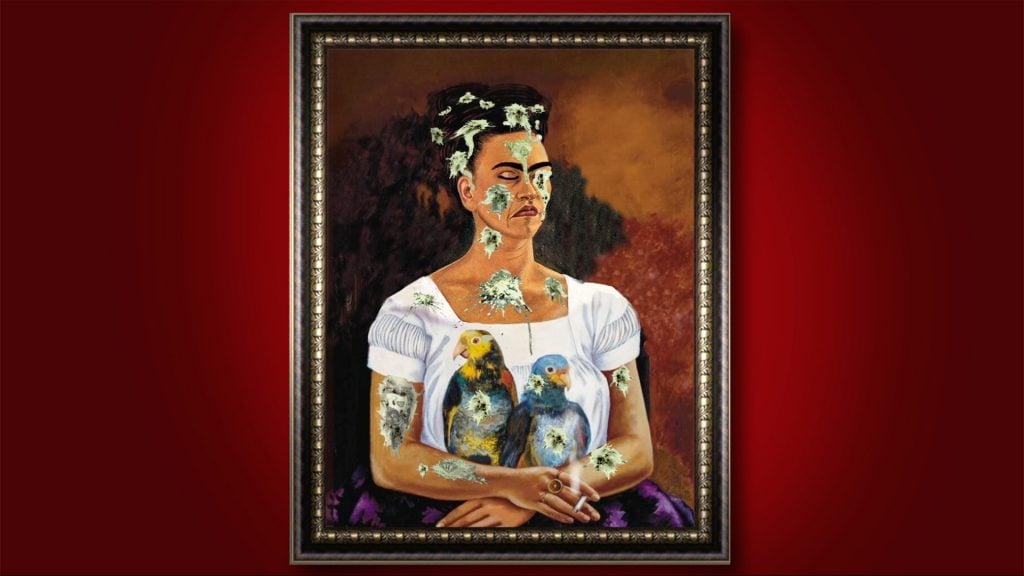



 —are trading for up to $1 million, and many projects of generative digital NFTs are skyrocketing as well, often launched on the platform
—are trading for up to $1 million, and many projects of generative digital NFTs are skyrocketing as well, often launched on the platform 
